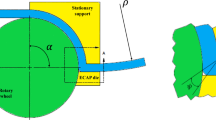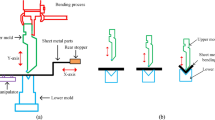Abstract
This paper deals with an 8-bar mechanism, which finds its application in a deep drawing press. It is required in the process of deep drawing that the slider maintains an almost constant velocity during a portion of the return stroke. The approach for the kinematic simulation is based on loop closure analysis, which has been performed to derive expressions for slider displacement, slider velocity and slider acceleration. An extensive sensitivity analysis is carried out to identify key parameters affecting the mechanism. A modified Multiple Linear Regression (MLR) method is introduced, by splitting the displacement plot into three regions to consolidate the results, in order to account for an otherwise erroneous path generated by using the conventional MLR equation treating the plot as a single region. As an alternative method Artificial neural network (ANN) is introduced for consolidation of data. It is shown that ANN also proves to be a better and easier procedure for data consolidation. The consolidated data is used to derive the objective function for optimization. Genetic Algorithm is adopted for optimizing the mechanism with respect to the sensitive link lengths, satisfying the objective function.














Similar content being viewed by others
References
Krishnamurthy Y, Balasubramanyam C, Gangopadhyay AK (1986) Optimisation of link drive mechanism. In: 12th AIMTDR conference
Soong RC, Hsu KS, Weng F-T (2008) A programmable geared seven-bar mechanism for mechanical forming presses. J Chin Soc Mech Eng 29(1):61–67
Hsieh W-H, Tsai C-H (2011) On a novel press system with six links for precision deep drawing. Mech Mach Theory 46:239–252
Chanekar PV, Ghosal A (2013) Optimal synthesis of adjustable planar four-bar crank-rocker. Mech Mach Theory 69:263–277
Russell K, Sodhi RS (2005) On the design of slider-crank mechanisms. Part I: multi-phase motion generation. Mech Mach Theory 40:285–299
Russell K, Sodhi RS (2005) On the design of slider-crank mechanisms. Part II: multi-phase path and function generation type mechanisms for approximate multi-path generation. Mech Mach Theory 40:301–317
Shen Q, Al-Smadi YM, Martin PJ, Russell K, Sodhi RS (2009) An extension of mechanism design optimization for motion generation. Mech Mach Theory 44:1759–1767
Gotlih K, Lojen DZ, Vohar B (2007) Optimisation of needle penetration velocity using the link drive mechanism in a sewing machine. In: 7th international conference on X-ray investigations of polymer structure, vol 15, pp 66–71
Tanik E, Parlaktas V (2011) A new type of compliant spatial four-bar (RSSR) mechanism. Mech Mach Theory 46:593–606
Li H, Zhang Y (2010) Seven-bar mechanical press with hybrid-driven mechanism for deep drawing, part 1: kinematics analysis and optimum design. J Mech Sci Technol 24(11):2153–2160
Stockton DJ, Khalil R, Ardon-Finch J (2008) Control point policy optimization using genetic algorithms. Int J Prod Res 46(10):2785–2795
Solimanpur M, Ranjdoostfard F (2009) Optimization of cutting parameters using a multi-objective genetic algorithm. Int J Prod Res 47(21):6019–6036
Hongsen Y, Chen Weiren A (2000) A variable input speed approach for improving the output motion characteristics of watt-type presses. Int J Mach Tools Manuf 40(5):765–790
Yossifon S, Shivpuri R (1993) Analysis and comparison of selected rotary linkage drives for mechanical presses. Int J Mach Tools Manuf 33(2):175–192
Yossifon S, Shivpuri R (1993) Optimization of a double knuckle linkage drive with constant mechanical advantage for mechanical presses. Int J Mach Tools Manuf 33(2):209–222
Connor AM et al (1995) The synthesis of hybrid five-bar path generating mechanisms using genetic algorithms. In: Genetic Algorithms in Engineering systems: innovations and applications, pp 313–318
Seth B, Vaddi SS (2003) Programmable function generators-1: base five-bar mechanism. Mech Mach Theory 38(4):321–330
Vaddi SS, Seth B (2003) Programmable function generators-2: seven-bar translator-out mechanism. Mech Mach Theory 38(4):331–343
Wang X (2013) The optimization of design of six-bar linkage mechanism. TELKOMNIKA 11(7):4091–4098
Pennock GR, Israr A (2009) Kinematic analysis and synthesis of an adjustable six-bar linkage. Mech Mach Theory 44:306–323
Tanaka H, Shibutani Y, Izumi S, Sakai S (2012) Planar mobility modes of 8-bar-jointed structures with a single degree of freedom. Int J Solids Struct 49(13):1712–1722
Pennock GR, Raje NN (2004) Curvature theory for the double flier eight-bar linkage. Mech Mach Theory 39(7):665–679
Huang Z-K, Chau K-W (2008) A new image thresholding method based on Gaussian mixture model. Appl Math Comput 205(2):899–907
Cheng C-T, Lin J-Y, Sun Y-G, Chau K (2005) Long-term prediction of discharges in Manwan Hydropower using adaptive-network-based fuzzy inference systems models. Lect Notes Comput Sci 3612:1152–1161
Taormina R, Chau K-W, Sethi R (2012) Artificial Neural Network simulation of hourly groundwater levels in a coastal aquifer system of the Venice lagoon. Eng Appl Artif Intell 25(8):1670–1676
Wu CL, Chau KW, Li YS (2009) Predicting monthly stream flow using data-driven models coupled with data-preprocessing techniques. Water Resour Res 45:W08432
Zhang J, Chau K-W (2009) Multilayer ensemble pruning via novel multi-sub-swarm particle swarm optimization. J Univers Comput Sci 15(4):840–858
Chau KW (2007) Application of a PSO-based neural network in analysis of outcomes of construction claims. Autom Constr 16(5):642–646
Aiken LS, West SG, Pitts SC (2003) Multiple linear regression. In: Handbook of psychology, Part Four, vol 19. Wiley, pp 481–507
Balasubramanyam C, Ajay MS, Amogh BS, Spandana KR, Seetharamu KN (2014) WSEAS TRANSACTIONS on MATHEMATICS 13:406–415
Balasubramanyam C, Ajay MS, Shetty AB, Spandana KR, Seetharamu KN (2014), Kinematic analysis and optimization of a 6 bar mechanism. In: International conference on mathematics and computers in sciences & industry. Organised by the IEEE, Varna, Bulgaria
Acknowledgments
We would like to acknowledge Mr T. S. Ashwin for helping us with Artificial Neural Network (ANN). This work is supported in part by the TEQIP 1.2.1 research grant (World Bank), for the Centre of Excellence in Knowledge Analytics and Ontological Engineering (KAnOE) at PES Institute of Technology, Bangalore-560085, India.
Conflict of interest
The authors hereby declare that they have no conflict of interest.
Author information
Authors and Affiliations
Corresponding author
Rights and permissions
About this article
Cite this article
Balasubramanyam, C., Shetty, A.B., Spandana, K.R. et al. Analysis and optimization of an 8 bar mechanism. Int. J. Mach. Learn. & Cyber. 6, 655–666 (2015). https://doi.org/10.1007/s13042-015-0368-z
Received:
Accepted:
Published:
Issue Date:
DOI: https://doi.org/10.1007/s13042-015-0368-z




